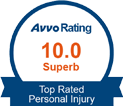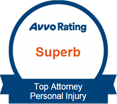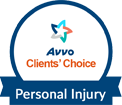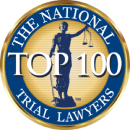When a signal changes to yellow, a motorist is cautioned that the traffic flow through the intersection will change shortly. The wisest decision to make then is to slow down and stop. However, most drivers in California speed through an intersection before the light turns green. It could result in an intersection accident and severe injuries. Fortunately, you have a right to compensation. At The Personal Injury Attorney Law Firm, we know how distressing the collision can be. As a result, we can help you recover the loss incurred.
Understanding the Driver's Responsibility at Intersections
Many intersection car accidents in California involve the disregard of the yellow and red lights. It is because most drivers don't know about their responsibilities at intersections. Here is a comprehensive guide on how motorists are supposed to act when they see a red or yellow light. It will also help you in holding the driver accountable.
1. Red Lights
Red Arrow Steady
It can be dangerous to turn left. Most California cities have installed left signal arrows as a way of reducing the rate of intersection car collisions. When nearing a steady red arrow, the motorist should stop:
- Before entering an intersection
- Before getting in the crosswalk near the intersection
- At the well-marked limit line
It is illegal for the driver to make a left turn while the arrow traffic signal is a steady red light. They can also make the turn once the traffic signal starts flashing yellow or turns green.
Red Light Steady
When nearing a steady red light, a motorist should stop:
- Before entering an intersection
- Before joining the crosswalk on the near side of the intersection
- At the well-marked limit line
Under Vehicle Code 21453 VC, the motorist should not move through the intersection until it's safe to make a right turn, or the traffic signal is green.
2. Yellow Lights
Yellow Arrow Flashing or Yellow Light
Sometimes, the traffic signal will show a yellow arrow or flashing yellow traffic signal. In this scenario, drivers are allowed to use the lanes to make a left-hand turn. The turn may only be made when the motorist reasonably believes that the turn will be made safely. Additionally, the driver should yield to all approaching pedestrians and traffic.
Yellow Light, Steady
Per California VC 21452, a yellow light means a red signal will appear soon. It could change in a few seconds. Therefore, drivers should be cautious and start slowing down when nearing a yellow traffic signal.
Four-Way Stop
Now and then, the intersection will have several stop traffic signals instead of changing signals. Any motorist approaching a stop signal should stop and give way to the motorist in the immediate right.
Non-Intersection Highway Entry and Crossing
From time to time, a motorist will require to cross or enter a road from a driveway, which isn't marked by signals.
- Crossing the Highway - A driver who wants to cross a road at any location apart from an intersection can cross. Nevertheless, they should yield to all approaching traffic and pedestrians using the road. The driver can then cross after ensuring the road is safe. Approaching traffic should then give the right of way to the crossing car.
Entering the Highway - Motorists wanting to join the flow of traffic on the road should yield to traffic on the highway. The motorist can enter road safety once they get an opening. After the motorist has started entering the highway, approaching cars should give the right of way to the driver to prevent a crash.
What are the Causes of Intersection Car Accidents?
Intersection car accidents are different from any other type of car accident in California because they are not always the liability of the motorists involved. Sometimes, road construction or roadway design defects could contribute to the collision. Roads that aren't well designed to permit a driver a line of sight to see the continuation of the highway or posted speed limit signals could result in severe accidents or even death. Additionally, improper timing or malfunctioning traffic signals could result in intersection car accidents.
Other common causes of accidents include:
Failing to Stop at a Red Light
As previously mentioned, a driver should stop at a red light. Also, a driver should not pass a red light without stopping when they are making a right turn at an intersection. A driver who doesn't stop at a red light before making a turn doesn't have adequate time to analyze the traffic conditions properly. As a result, the driver does not see approaching pedestrians or traffic while making the turn hence causing an accident.
Speeding to Beat Yellow Light
Most drivers don't want to wait through the red traffic signal and try speeding through the intersection as a way of beating the traffic light before it becomes red. This behavior could result in a higher risk of injury to all persons involved. Often the driver will go beyond the speed limit and, as a result, crash with cars which are turning before the traffic light turns.
Left Turns
Turning left is challenging, and impatient drivers who don't check for approaching pedestrians or traffic cause car collisions.
Rear-End Accidents
Many rear-end car accidents occur at intersections. There is no rule on what is expected of motorists at a yellow traffic light. Sometimes, the accident may occur because the driver is abstracted at red traffic lights. Once you fail to notice that the traffic light has changed to green, an aggressive driver behind you could rear-end you.
Negligence
Negligence is another common cause of several intersection collisions. All drivers should drive safely, comply with all traffic laws, understand their responsibility at intersections, and be cautious to stop the danger of causing an accident. When a motorist fails to maintain their duty to care, they will be accountable for any resulting injury.
Sometimes an accident is due to pure negligence but then again doesn't involve violating the law. While others require action that breaks a traffic law, it is easier for you to be awarded compensation.
Breaking law is called negligence, per se. It means you don't have to present evidence that the defendant was negligent. All you have to do is prove that the defendant broke the law that was designed to stop the accident from occurring.
Proving Liability in an Intersection Car Accident
Fault in a car accident is founded on negligence. The negligent motorist is accountable to passengers and other motorists for damages stemming from the intersection accident. Negligence is based on breaking traffic laws or driving without due care.
Fault can also depend on other factors like traffic signals, vehicle defects, and road conditions. Nonetheless, most intersection accidents are as a result of one or more drivers driving with no due care of other road users.
According to negligence laws in an automotive accident, the negligent party is responsible for any damage and injuries caused to the victim. To be awarded compensation, you should prove the liable party was negligent in causing the car accident. The facts of negligence include:
- The defendant owed you a duty of care
- The defendant breached the duty of care by being negligent
- The defendant's negligence caused your injury
Failing to use reasonable care when driving in California is negligence. The duty of care for driving requires:
- Checking out for obstacles, pedestrians, and other cars
- Regulating the movement and speed of the car
- Using reasonable care when driving
Various Injuries Suffered in an Intersection Accident
Injuries sustained in this type of car accident vary depending on factors such as the speed of the crash, airbags, angle of impact, vehicle type, and seatbelt use. The injuries are more severe if the accident occurred on a vehicle’s side. It is because the vehicle's side has a narrow protection layer between the passengers and the outside. Additionally, the passengers can be trapped inside until emergency responders rescue them.
While some intersection car collisions are fender benders, fatal accidents that result in severe injuries are also common. Although, you can suffer any type of injury in the accident, here are the most common intersection accident injuries:
- Traumatic Brain Injury (TBI) - Usually, a TBI is due to violent shaking of your head or forceful blow to your head. Since TBI affects the brain, it is often hard for victims to cope with it. A TBI can also cause physical, behavioral, cognitive, emotional, or sensory damage.
- Broken Bones - These injuries heal slowly hence very painful. The injury will slow a victim down physically as well as cause severe health complications like permanent disabilities.
- Whiplash - This injury is excruciating, heals slowly, and physically debilitating. It is also unpredictable. It can manifest immediately or creep up on you over time.
- Spinal Cord Injury (SCI) - Damage to your spinal column or spinal cord can result in SCI. Since a spinal cord coordinates movement, a severe SCI can result in partial or complete paralysis.
Damages Awarded in a Personal Injury Claim
Damages can be defined as the losses related to an injury. In California, damages include economic and non-economic damages. Economic damages are damages with a distinct dollar value, such as vehicle repair and medical expenses. Non-economic damages, on the other hand, are hard to calculate and involve compensation for loss of consortium, pain and suffering, and emotional distress.
Common damages awarded include:
Vehicle Damage
You are also entitled to receive compensation for your car repair bills paid after the accident. The liable party should also pay for the cost of renting a car while your car is being repaired.
If you have optional collision insurance with your car insurance, the insurance provider should pay the cost of replacing or repairing the car after the accident, irrespective of who is responsible. Collision coverage isn't a requirement in California, but most drivers have it, especially if their motor vehicle is high-end. Using collision coverage is the easiest method to get a car repaired after a collision. The insurance company will then seek reimbursement from the liable party.
If you don't have collision coverage, you have numerous options to have the car repaired.
First, if the at-fault party has car insurance, you can:
- Pay for the car repairs and then seek reimbursement from the defendant or their insurer
- Wait until your personal injury claim is settled in full to repair your car
- Settle only the property damage with the insurance provider while negotiating a settlement for other damages
Second, if the liable party is uninsured, you can:
- Settle your claim directly with the liable party
- Take legal action against the defendant
If you have an uninsured/under-insured motorist (UM/UMI) coverage, you can seek reimbursement from your insurer.
Medical Bills
It covers all medical expenses currently incurred or will be spent in the future as a result of the accident. The compensation can be made directly by the defendant, at-fault company, or by the defendant's insurance provider. To be awarded this damage, you need to submit copies of expenses incurred. You could also be required to provide your diagnosis and copies of test results like MRIs and x-rays.
Lost Wages
Lost wages include all the amount you would have made had you not suffered the injuries. They can consist of your regular pay, overtime pay, bonuses, commissions, sick days, and vacation days.
You are also entitled to recover lost earning capacity (the income you will not be in a position to make in the future as a result of the intersection accident). Proving lost earning capacity is complicated and requires testimonies from occupational experts and doctors.
Pain and Suffering
Pain and suffering are subjective losses and are not easy to attach a dollar value. In most cases, there is no cap on this type of damage.
Also, there is no standard method in California for determining the value of pain and suffering suffered. You should prove that you have suffered the harm. Then the judge uses their judgment to determine a fair amount based on common sense and evidence presented.
Loss of Consortium
Your spouse is also entitled to recover damages for the loss of your regular relations and companionship. These non-economic compensatory damages seek to compensate for the loss of moral support, intimacy, and companionship after a wrongful injury.
What to Do After a Loved One Has Been Killed in the Accident
If your loved one dies as a result of the intersection collision, that individual isn't around to bring a personal injury claim against the responsible party. However, as a surviving family member, you can bring a claim under survivor cause of action or wrongful death.
You will be able to recover the following damages:
- Funeral expenses
- Burial expenses
- Lost income the victim would have made had they not died
- Compensation for loss of support and companionship
In California, only the following can bring a wrongful death lawsuit:
- Decedent's spouse
- Domestic partner
- Children
- Deceased's grandchild if the children are dead
- Any other person entitled to the deceased's property under intestate succession laws
Can You File a Claim if You are Partially to Blame for the Intersection Accident?
You can still receive compensation if both you and the other parties involved are at fault, or you are not sure who caused the collision. However, under comparative fault rule, your damages will be reduced by the percent of your fault.
Sometimes, you could be deemed negligent even though you didn't cause the crash. For instance, it can be a valid defense to the at-fault driver that you had not buckled your seat belt. In this case, you could have been negligent in case you:
- Had a functional seatbelt
- A reasonably cautious individual in your situation could have worn the seatbelt
- You did not use your seatbelt
- Your injury could have been prevented or less severe if you wore your seatbelt
Proving fault and negligence in an intersection car accident is complicated, particularly when every party is telling a different story. Therefore, you should speak with your personal injury attorney about the case. The attorney will help you know the various damages you are entitled to.
Steps to Take After an Intersection Auto Accident
An accident occurs fast, and often, you do not see it coming. Immediately after the accident, it might be challenging to wrap your head around what steps you should take. Discussed below are practical tips on steps to take following the accident:
Safety First
It is advisable to get your vehicle out of the way of traffic if no person is severely injured, and you can move your motor vehicle. Sometimes remaining at the intersection can result in another accident.
If you cannot move the vehicle, stay put. Don't get out of the motor vehicle and into the traffic.
Also, ensure every person in the car has worn their seatbelt.
Finally, turn hazard lights on. That way, other motorists will see you.
Assess Your Injuries and Gather Information
The next step involves checking if any person has sustained an injury. If any person requires medical care, get help straight away. It will prevent injuries from becoming worse. Additionally, it offers proper documentation that will be necessary later for personal injury lawsuit purposes.
Make sure you exchange information with all parties involved. Obtain insurance details from all drivers in a multi-vehicle collision, even if only one vehicle hits you. To be sure the details are accurate, take photos of all insurance cards (both back and front).
Another essential method of gathering information is capturing photographs. If you can do so safely, take photos of all the cars involved, people, and any injuries. Take pictures of factors that could have played a role in the collision like traffic, road signals, intersection, weather hazards, construction, and other obstructions. Also, capture scrapes to debris and guard rails and skid marks.
Finally, obtain names and contact details of any witnesses. You can also document what they saw should there be any questions later.
Report the Intersection Accident to the Police
Police do not always come to the accident scene if the accident does not involve any injuries. If they come, the officer will draft an official report about the car accident. Remember to enquire from the officer how to obtain a copy of the police report.
A police report is a written recollection of what the officer has studied about the collision. The report often has evidence about accountability, like the police's opinion that one driver was speeding founded on observation of skid marks' length.
The report is an essential piece of evidence you can present to your insurer. The insurance provider could be hesitant about providing an auto accident liability report without first getting a police report copy.
Make sure you have every error in the report fixed. If the flaws involve factual errors such as wrong insurance or vehicle details, you can revise the police report by showing the officer that information.
Report the Accident to Your Insurance Provider
You will also be required to inform your insurer of the automotive accident and start the claim process. Study your policy thoroughly and know your available options before providing the insurance company with any statement about the accident.
Avoid providing any recorded information. The insurance firm may use it to alter or deny your claim.
Keep Records of All Costs Incurred
To receive fair compensation for all damages incurred, you need to present evidence of all costs incurred.
Keep copies of all medical expenses, medical records, and medical bills. Moreover, maintain documentation that shows the lost income and missed work as a result of the accident.
Be sure to take your car to a reputable automotive repair shop that can get you a written estimate for fixing the vehicle damage. Finally, keep all receipts and tow bill for a rental motor vehicle you use while your car is not operable or in the repair shop.
Finding a Personal Injury Attorney Near Me
A fender bender car accident can interrupt your life, while a serious accident can result in long-lasting injuries like TBI. In case of catastrophic injuries, medical attention will be extensive with the need for personal help for a couple of months, or even years. If the car accident was due to negligence, the responsible party should be held liable. However, filing a personal injury lawsuit in California isn't straightforward, hence giving rise to countless questions about the case. For many years, The Personal Injury Attorney Law Firm has helped thousands of accident victims, including intersection accidents, get fair compensation from those responsible. Call us today at 619-625-8707 to get your questions answered.
Recommended: Los Angeles Personal Injury Attorney, Las Vegas Personal Injury Attorney
 800-492-6718
800-492-6718







